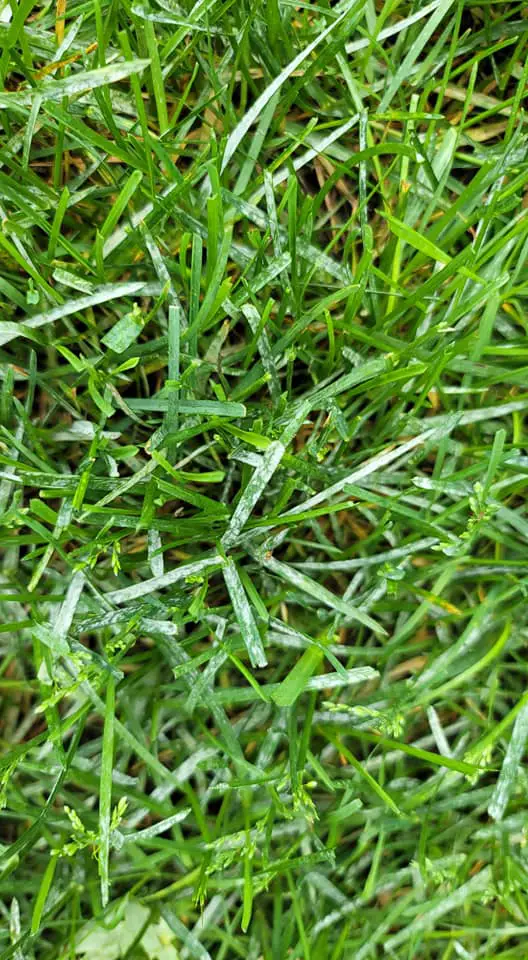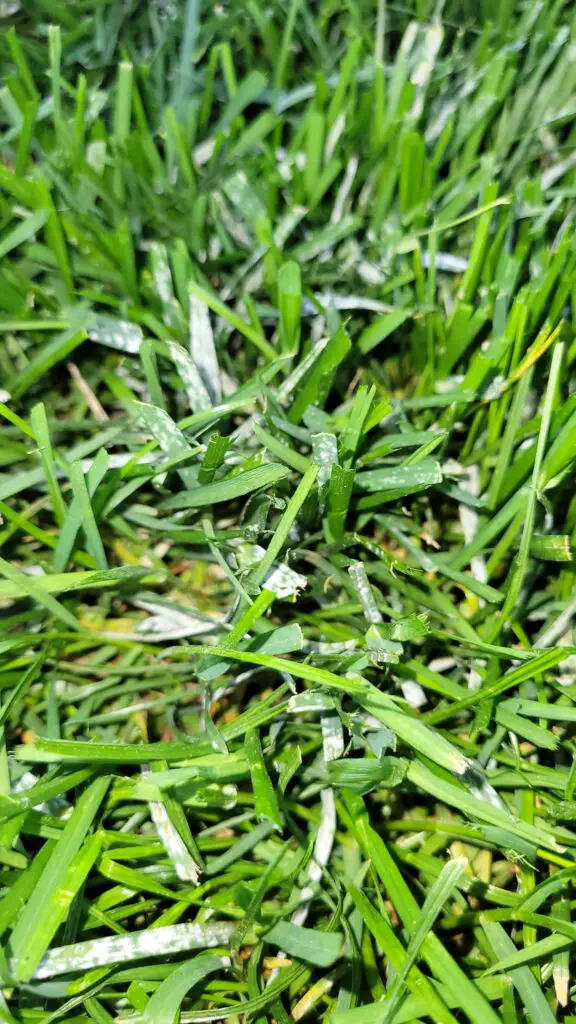You’ve probably seen it around: white, powdery stuff that shows up on leaves, stems, and even flowers of everything from vegetables and woody ornamentals to other plants like trees and grasses.
Yes, I’m talking about powdery mildew, one of the most common plant diseases. If we don’t keep it in check, it spreads, affects plants, and reduces their ability to grow and produce flowers.
Below, I’ll discuss the nuances of powdery mildew, the symptoms it causes, and take a look at some effective treatment strategies.
What is Powdery Mildew?
In plain English, it’s a fungal disease: a group of fungi called Erysiphaceae. From a technical point of view, the disease is host-specific, meaning there are different types of fungi within this family that infect different types of plants, but they all cause similar and common symptoms.
One of these fungi, Blumeria graminis (or Erysiphe graminis in older books), is our culprit in the case of grasses.
When a plant gets infected, you’ll see these white or grayish patches that look like talcum powder on the stems, fruits, and leaves. These patches are actually the fungus’s asexual spores, known as conidia.
If you look closely, you might also see these tiny, round structures that start off white, then turn yellow-brown, and eventually black. These are called cleistothecia, and they help the fungus survive the winter and continue its life cycle.
The spores of powdery mildew disease are like seeds but for fungi. They can easily spread through the wind, which means they can infect plants both nearby and far away, giving them a bit of an evolutionary edge.
Once these spores land on a host plant, they quickly germinate, typically within 2 hours, and start a new infection.
Some powdery mildews need high humidity to germinate, but other strains can do just fine with low humidity. Unlike other fungi that cause leaf spots, these guys don’t necessarily need moisture like rain or dew to infect a plant.
They form a kind of growth mat, known as mycelia, on the plant’s surface and develop special structures called haustoria that penetrate the plant tissue to get to the nutrients they need.
The spores are produced in long chains that eventually break off and get carried away by the wind to infect new plants. This lawn disease fungi really love places with cool, moist nights that help with spore production and warm, dry days, usually between 70 and 80 degrees Fahrenheit, that let the spores spread around.
How to identify powdery mildew on turfgrass
The identification of this fungal lawn disease isn’t complicated at all. The most common symptom is when the lawn appears as if it’s been dusted with flour or powdered sugar. Upon closer inspection, isolated white patches can be seen on the grass blades, a telltale sign of this disease.
As the powdery mildew infection gets worse, those white patches start to spread and cover the entire leaves or grass blades, forming a dust-like layer.
If you look closely, you might notice tiny black dots appearing within the white powder. These are the fungus’s fruiting bodies, which are basically its reproductive organs.
If the infection progresses to the final phase, the grass might start to turn yellow and could even die off completely. That’s why it’s important to keep an eye out for those first scattered white powder.
Catching the fungus early gives you the best shot at treating it effectively before it takes over your whole lawn. So, act quickly at the first signs!
What causes powdery mildew in lawns
As I told you before, as one of the turf diseases, powdery mildew is initiated by a fungus called Blumeria graminis.
In the biology world, the disease is a member of the obligate parasites club, which means it can only survive by living on a host plant, like your lawn grass.
The growth of this fungus and the development of the disease are influenced by several factors:
- High relative humidity without visible free water on the leaf blades’ surfaces
- Poor air circulation
- Low light intensity
- Air temperatures between 60 and 70 degrees Fahrenheit
This obligate parasite survives unfavorable environmental conditions by remaining dormant within infected areas.
Most susceptible grasses to powdery mildew
Powdery mildew fungi can affect lots of different types of turf grass, all grasses are susceptible somehow. But how bad the disease gets can depend on the type of grass and how it’s growing.
Kentucky bluegrass (Poa pratensis) is a real favorite for our lawn fungus, especially in shady areas with moderate temps and high humidity.
Various grass varieties have different levels of resistance to the disease, though. For example, tall fescues can be a good pick for shady locations since they’re not as prone to the fungus.
Some types of fine fescue, like hard fescue (Festuca brevipila), chewings fescue (Festuca rubra ssp. commutata), and red fescue (Festuca rubra), are also less likely to get powdery mildew compared to Kentucky bluegrass.
Breeding programs are working on introducing new, more resistant grass species to help control the disease. By choosing the right grass species or cultivars, you can lower the risk of disease and keep your lawn looking healthy.


How to get rid of powdery mildew on lawns
Of course, altering prevailing environmental conditions like a humid climate isn’t possible at all, unless you’re a superhero! However, changing your lawn’s cultural environment is an achievable way to minimize lawn disease.
The good news is that treating powdery mildew is relatively simpler compared to controlling other turf grass issues and diseases, even better; it’s DIY-friendly.
With just a few adjustments to your lawn care routine, you’ll have an effective powdery mildew-kill strategy:
- To help your infected turf, try removing or moving plants and pruning trees that are blocking airflow to improve air circulation.
- Make sure the affected areas get more sunlight penetration by trimming or pruning any plants that are in the way.
- Adjust your watering schedule so that shady spots don’t stay too wet. The best time to irrigate is in the morning before 10 a.m. Water deeply, but not too often.
- Be careful with nitrogen fertilizers like urea or ammonium. Too much nitrogen fertilizer can make your grass grow too much, which can lead to poor air circulation – a perfect environment for spores. Always do a soil test to figure out the right amount and type of fertilizer for your lawn.
- If you can’t change your lawn’s environment, you might need to apply fungicides. Look for ones that contain myclobutanil, propiconazole, or triadimefon to help fight this disease effectively.
How to prevent powdery mildew on your lawn
Powdery mildew loves warm, dry climates, but needs high RH for its spores to germinate.
That’s why you’ll often see fungal growth in crowded plantings with poor air circulation and in damp, shady spots. The infection rate goes up when the RH hits 90%, but interestingly, it doesn’t occur when the leaf surfaces are completely wet, like during a rain shower.
Usually, it’s the young, tender growth that’s more likely to get infected than the older plant tissues.
Cultural Practices to Treat Powdery Mildew
To help keep powdery mildew at bay, plant shade-tolerant grass such as hard fescue, chewings fescue, or red fescue, all of which are fine fescues. A mix of Kentucky bluegrass, tall fescue, and fine fescue is a great combo for shaded spots.
Turf that grows in the shade requires different maintenance than grass in full sun. Shade grass requires less nitrogen, less water, and tolerates lower mowing heights.
Apply no more than 1 pound of nitrogen per 1,000 square feet, maintain a mowing height of about 3 inches to promote rooting and provide more leaf surface area for photosynthesis. Water deeply but not too often to promote root growth and reduce leaf wetness.
Avoid light, and frequent irrigation just before sunset or after sunrise, as prolonged leaf wetness can speed up lawn disease development.
Another thing you can do is prune, remove, or carefully position trees and shrubs to let in more light and air movement, which can help control powdery mildew and prevent future outbreaks in shaded areas.
Chemical Controls to Treat Powdery Mildew
By using the right care and maintenance practices, preventing powdery mildew to a manageable level ispossible, which means you might not even need to use fungicides. But if the disease gets out of hand, fungicides can be used as a way to treat it.
To minimize the use of fungicides, try mapping out the affected areas so you can target your treatment.
Here’s a table of fungicides that can be used against this turfgrass disease, along with an example product for each active ingredient. Keep in mind:
- When selecting a product, check out the active ingredients listed on the label. You might be looking for a specific active ingredient, which could also come with other chemicals.
- The important thing is to find the right active ingredient, regardless of whether the product contains other chemicals or not.
| Fungicide | Fungicide Class | Application Interval (days) | Efficacy | Product |
| Copper hydroxide + mancozeb | Inorganic + dithiocarbamate | 7-14 | limited data available | Junction |
| Myclobutanil | demethylation inhibitors or triazole fungicides | 14-28 | excellent control | Eagle |
| Fenarimol | demethylation inhibitors or triazole fungicides | 1x | excellent control | Rubigan |
| Triadimefon | demethylation inhibitors or triazole fungicides | 15-30 | excellent control | Bayleton |
| Propiconazole | demethylation inhibitors or triazole fungicides | 14-28 | excellent control | Banner MAXX |
FAQs
What is the main cause of powdery mildew?
Powdery mildew is mainly caused by a fungal disease from a family of fungi called Erysiphaceae. When it comes to grasses, the main fungus responsible for powdery mildew is Blumeria graminis, also known as fungus Erysiphe graminis.
Does powdery mildew spread?
Powdery mildew is contagious and can easily spread from one plant to another. The fungal spores can travel through the wind, water drops, tools, and even insects. If you leave any infected plant debris around, it can release spores and re-infect your plants next season. Make sure to promptly prune affected parts, rake up and dispose of fallen infected leaves and blooms, and sterilize your gardening tools after working with infected plants.
Can plants recover from powdery mildew?
The good news is that plants can recover from this turfgrass disease if treated in time. Increase air circulation and reduce moisture around infected plants. Water early in the day to allow the foliage to dry. Remove and destroy fallen leaves and cut branches to eliminate the source of fungal spores. Apply organic or chemical fungicides as needed to reduce infection.
Is powdery mildew harmful to grass?
Powdery mildew can be a real pain in the neck when it comes to lawn diseases. While it doesn’t kill the grass directly, bad infections can weaken the plant. You might notice stunted growth, yellowing, and poor health in areas with lots of mildew. The white masses on the grass blades blocks sunlight and messes up photosynthesis. Plus, the grass has a harder time getting nutrients from the soil. Over time, this can wear down the grass and make it more vulnerable to other stressors. In really severe cases, huge patches of turf can turn brown and die from the stress of powdery mildew.
